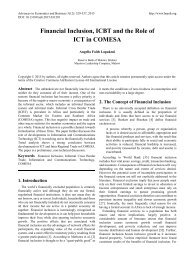FD
gvti301SEaf
gvti301SEaf
You also want an ePaper? Increase the reach of your titles
YUMPU automatically turns print PDFs into web optimized ePapers that Google loves.
surement of price change improved, with the introduction<br />
of price indices that adjust for quality changes in information<br />
technology equipment. Moreover, in contrast to the era<br />
before 1936, when there was no consumer price index (CPI)<br />
for automobiles, during the postwar years quality changes in<br />
new automobiles were carefully measured by the CPI, including<br />
the value of government-mandated antipollution devices.<br />
The third industrial revolution<br />
To understand the sources of today’s slow growth, consider<br />
the decline in the growth rate of labor productivity since<br />
1955 when a so-called Kalman filter is used to smooth the<br />
data and remove any correlation with ups and downs in the<br />
unemployment rate over the business cycle (see Chart 2). It<br />
shows that after 1955 labor productivity growth proceeded<br />
through four stages. It was fast in the 1950s and 1960s, slower<br />
from the 1970s to 1995, and fast again in a temporary revival<br />
from 1995 to 2004. Since then there has been a precipitous<br />
slowdown. The actual rate of productivity growth over the six<br />
years ending in 2015 was a mere 0.5 percent a year. Why did<br />
the productivity revival of the late 1990s die out so quickly?<br />
Most of the economy realized a one-time benefit from the<br />
Internet and Web revolution, but methods of production<br />
have changed little since. These major sectors include agriculture,<br />
mining, construction, retail trade, transportation,<br />
finance, insurance, real estate, professional and business services,<br />
education, health, arts and entertainment, accommo-<br />
Gordon, corrected 4/11/20106<br />
dation and food services, and government. In each of these<br />
sectors, paper-dependent business procedures typical of 1970<br />
had by 2005 been replaced by digitization, and flat screens<br />
were everywhere. The revolutions in everyday life made<br />
Chart 2<br />
Slowdown<br />
Labor productivity growth was rapid in the 1950s and 1960s,<br />
slower from the 1970s to 1995, and fast again until 2004<br />
and has been dramatically slower since then.<br />
(growth rate, U.S. productivity, percent)<br />
3<br />
2<br />
1<br />
0<br />
1955 65 75 85 95 2005 15<br />
Source: Gordon (2016).<br />
Note: A Kalman filter was applied to smooth the data and remove any correlation with<br />
ups and downs of the unemployment rate over the business cycle. Productivity is output<br />
per worker.<br />
possible by e-commerce and search engines were already<br />
well established—Amazon dates to 1994, Google to 1998,<br />
and Wikipedia and iTunes to 2001. Facebook was founded<br />
in 2004. Will future innovations be sufficiently powerful<br />
and widespread to duplicate the brief revival in productivity<br />
growth between 1996 and 2004? A look at many of the<br />
important economic sectors that experienced that revival<br />
suggest that the answer is, “Unlikely.”<br />
Stasis in the office: The digital revolution of 1970–2000<br />
utterly changed the way offices function. In 1970 the electronic<br />
calculator had just been invented, but the computer<br />
terminal was still in the future. Office work required innumerable<br />
clerks to operate the keyboards of electric typewriters<br />
that could not download content from the rest of the<br />
world. Memory typewriters were just being introduced, so<br />
there was still repetitive retyping. By 2000, though, every<br />
office was equipped with Web-linked personal computers<br />
that could not only perform any word-processing task but<br />
could also download multiple varieties of content and perform<br />
any type of calculation at blinding speed. By 2005 the<br />
introduction of flat screens had completed the transition to<br />
the modern office. But then progress stopped. The equipment<br />
used in office work and the productivity of office employees<br />
closely resemble the office of a decade ago.<br />
Stasis in retailing: Since the development of big-box<br />
retailers in the 1980s and 1990s, and the conversion of<br />
checkout aisles to bar-code scanners, little has changed in<br />
the retail sector. Payment methods have gradually changed<br />
from cash and checks to credit and debit cards. In the early<br />
years of credit cards in the 1970s and 1980s, checkout clerks<br />
had to make voice phone calls for authorization, then terminals<br />
that dialed the authorization phone number took<br />
over. Now the authorization arrives within seconds. Bigbox<br />
retailers brought with them many other aspects of the<br />
productivity revolution. They transformed supply chains,<br />
wholesale distribution, inventory management, pricing,<br />
and product selection. But that productivity-enhancing<br />
shift from traditional small-scale retailing is largely over.<br />
E-commerce raises productivity but still accounts for only<br />
about 6 percent of total retail trade (Hortaçsu and Syverson,<br />
2015). The retail productivity gains that are a major accomplishment<br />
of the third industrial revolution will be difficult<br />
to surpass in the next several decades.<br />
Stasis in finance and banking: The revolution in information<br />
and communications technology changed finance and<br />
banking along many dimensions—from the humble streetcorner<br />
ATM to the development of fast trading on the stock<br />
exchanges. But both the ATM and billion-share trading days<br />
are creations of the 1980s and 1990s. Nothing much has<br />
changed since. And despite all those ATMs, the United States<br />
Finance & Development June 2016 35














